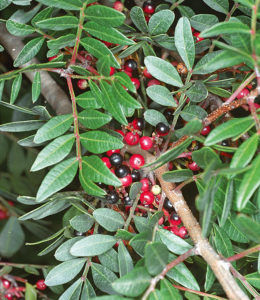
Find out more about the Gaultheria plant of our Aromatherapy Herbarium blog series.

GAULTHERIA
Wintergreen
Gaultheria fragrantissima
DESCRIPTION

Gaultheria is a small shrub less than fifteen centimetres tall of the Ericaceae family, which grows in the forests of Nepal (Gaultheria fragrantissima syn. punctata) as well as in China (Gaultheria yunnanensis) and in North America (Gaultheria procumbens).
ADVICE
Skin application is recommended. However, pure essential oil of gaultheria may sometimes irritate the skin, especially in sensitive persons, and should be used preferably diluted in carrier oil (maximum 25% of essential oil concentration). It may be used pure on a small surface, but one should be prepared for its revulsive, vaso-dilator and heating effect which may be irritant. Test on skin prior to use.
DO NOT USE IN
– pregnant or breast-feeding women,
– children under the age of six years,
– persons allergic to aspirin or to salicylates in general,
– in case of anticoagulant treatment.
RECIPES
Muscle cramps
Dilute 2 drops of essential oil of gaultheria in 10 drops of arnica carrier oil. Apply this preparation before and after exercise.
Sprains, traumatic contusion
2 drops of EO of gaultheria, 2 drops of EO of helichrysum, 5 drops of CO. Apply by massaging gently twice daily for seven days.

Its white to pale pink flowers are located at the base of the leaves and are bell shaped. They give scarlet red berries from October to March.
Gaultheria is named after Jean-François Gaulthier (1708-1756), royal physician botanist in Quebec. He observed that Inuits and Indians in Canada had been chewing or making infusions of gaultheria leaves to bring down fever and relieve pain since the dawn of time. This fairy of the Great North, called “mountain tea” in Quebec played an important role in pharmacology: in the 19th century North America supplied Europe with “essence of wintergreen”, extracted by steam distillation from the entire plant. In 1844, William Proctor, “the father of American pharmacy” and the Frenchman Auguste Cahours isolated the main component of this essential oil, “methyl salicylate” then Cahours synthesised salicylic acid by hydrolysis, which was used as a medicine for rheumatism before the synthesis of acetylsalicylic acid, a molecule better known by the brand name of aspirin.
CULTIVATION AND PRODUCTION
Gaultheria is nowadays mainly harvested in Nepal, in the Himalayas. In this country, the plant is taller and easier to harvest than in North America where this back-breaking work which was reserved in the past for Indians, immigrant children and women, no longer attracts many volunteers!
FRAGRANCE
Its warm, strong and woody scent is very powerful. You can smell it in gymnasiums, as gaultheria is found in the creams used by masseurs against tendinitis and pulled muscles.
EXTRACTION AND YIELD
Essential oil of gaultheria is extracted from the leaves, which are soaked overnight in hot water to obtain methyl salicylate by enzymatic fermentation, and they are then distilled with steam. This fermentation releases the aromatic compound from its bond to complex sugars which are too heavy to be distilled by the steam. The yield is of 1.5% to 2%, one hundred kilograms of leaves give a litre and a half of essential oil.
CHEMICAL FORMULA
Essential oil of gaultheria is composed of nearly 99% methyl salicylate. It is thus one of the rare essential oils to be almost mononuclear.
MAIN INDICATIONS
Essential oil gaultheria, an anti-inflammatory and analgesic, is brilliant for all muscular pains related to an intense physical effort: lumbago, elongation, sprain, cramps, back pains. It fights the common rheumatisms in the cold and humid climates where the plant thrives.


Leave a Comment